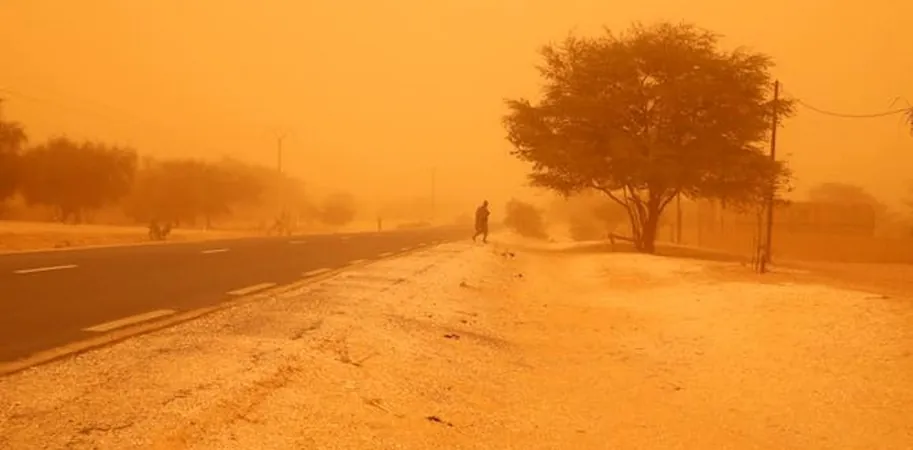
The Harmattan: More Than Just Dust—Unveiling the Health Risks of West Africa's Seasonal Wind
2025-03-30
Author: John Tan
What is the Harmattan?
The Harmattan arises during the Northern Hemisphere’s winter months (October to March), which causes significant shifts in atmospheric circulation. The inter-tropical convergence zone, where moist air from the south meets the dry air of the north, migrates from the Sahel toward the Gulf of Guinea. The difference in atmospheric pressure between these two regions drives the formation of the Harmattan, resulting in dry air that diminishes visibility and impacts agricultural practices.
Dryness and its Dangers
As the Harmattan wind flows southward, it passes over the arid Sahara, retaining its dryness. Regions experiencing the Harmattan undergo extreme temperature variations: cool nights followed by extremely hot days, especially between March and April. This pattern leads to intensified winds, particularly during dawn, which exacerbate conditions on vulnerable soils, creating a dust-laden atmosphere.
The Bodélé Depression in Chad is noteworthy for being the world’s leading source of fine dust particles, contributing significantly to the dusty air carried by the Harmattan across West Africa.
Health Implications
The Harmattan is not just an environmental phenomenon; it poses serious health risks. Dust particles carried by the wind can lead to respiratory problems, like bronchitis and asthma, worsening the air quality significantly. The dry air boosts the spread of diseases such as influenza and makes bacterial infections like tuberculosis more prevalent. The system is particularly concerning in Sahelian countries, where high incidences of meningitis have been documented.
Recent studies highlight a striking correlation: a 15% increase in annual fine dust particles has been linked to a 24% rise in infant mortality rates in the region. This alarming statistic underlines the urgency of addressing the health challenges posed by the Harmattan.
Ecosystem Effects
The wind does not solely affect human health; local ecosystems are impacted as well. Significant surface water evaporation accelerates soil erosion, diminishing land productivity. Moreover, Harmattan winds may disrupt aviation due to decreased visibility and impair solar energy production, as dust accumulates on photovoltaic panels.
Protecting Against the Harmattan
To mitigate the Harmattan's adverse effects, scientists and meteorological agencies have launched extensive research and monitoring programs, notably through the European Copernicus initiative. Accurate forecasting becomes crucial as the season progresses—especially towards late April—when worsening air quality coincides with rising day temperatures.
Informed communities can take protective measures, such as covering mouths and noses with cloths, using saline solutions for airways, and vaccination against respiratory illnesses. Strengthening air quality monitoring and observational networks is vital, particularly in urban settings where pollution can exacerbate the Harmattan’s dangers.
Conclusion
While the Harmattan wind is a natural system deeply rooted in West Africa’s climate, its implications stretch far beyond the realm of weather. Addressing its health impacts is paramount as communities strive to navigate and adapt to the changes it unleashes annually. Understanding this seasonal wind is crucial—not merely for awareness, but for proactive measures that can protect health and well-being across the region.




 Brasil (PT)
Brasil (PT)
 Canada (EN)
Canada (EN)
 Chile (ES)
Chile (ES)
 Česko (CS)
Česko (CS)
 대한민국 (KO)
대한민국 (KO)
 España (ES)
España (ES)
 France (FR)
France (FR)
 Hong Kong (EN)
Hong Kong (EN)
 Italia (IT)
Italia (IT)
 日本 (JA)
日本 (JA)
 Magyarország (HU)
Magyarország (HU)
 Norge (NO)
Norge (NO)
 Polska (PL)
Polska (PL)
 Schweiz (DE)
Schweiz (DE)
 Singapore (EN)
Singapore (EN)
 Sverige (SV)
Sverige (SV)
 Suomi (FI)
Suomi (FI)
 Türkiye (TR)
Türkiye (TR)
 الإمارات العربية المتحدة (AR)
الإمارات العربية المتحدة (AR)